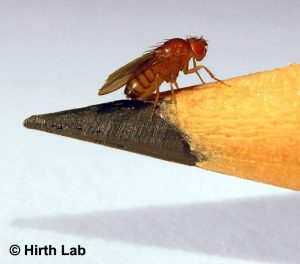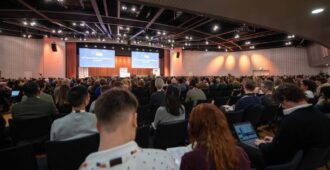
The MND Association has funded a number of research projects in the laboratory of Dr Frank Hirth at the Institute of Psychiatry, King’s College London. His area of expertise is in using fruit flies to understand how motor neurones die in MND.
There is an opportunity to read a summary of some of his work through an online competition. The article is called ‘The TBPH gene – do neurodegenerative disease have a fly in the ointment’ and it is has been shortlisted forThe People’s Choice award , as part of the Access to Understanding competition.
Please go online, read the article, ‘like it’ and add any comments you’d like to, until a deadline of 12 noon on 24 March.
A background (but hopefully not a spoiler!) to this summary and the competition is given below:
MND and TDP43
A characteristic sign of motor neurones affected by motor neurone disease is the clumps of protein visible down a microscope. Although these proteins have been observed in motor neurones from people affected by MND since the earliest descriptions in the 1870s, a key discovery was made when the identity of a protein, common to all types of MND was unveiled as ‘TDP43’ in 2008.
The importance of this discovery to all forms of MND was later backed up by finding that some people with the rare, inherited form of MND have a mistake in the TDP43 gene. The genetic mutation (mistake) gave researchers an opportunity to understand the effects of this protein – and how it causes motor neurones to die – in more detail. The genetic mutation acts as a trigger for these effects, and we can use that trigger in the lab.
Open access results

At the end of January 2013, Dani Diaper a researcher in Frank Hirth’s lab, published a paper on the effects of TDP43 in a fruit fly model of MND. The paper was a result of Dr Diaper’s PhD, funded by the MND Association.
The research paper was published using a process called ‘open access’. A copy of the paper is available in an online database the MND Association supports called Europe PubMed Central (Europe PMC).
To researchers ‘open access’ means that they can read the full results of the studies, without effectively having to ‘buy’ the report first. This is true whether they are based in a university, a hospital or a biotech company. It’s a bit like wanting to read newspapers on your computer – some of them are available for free and some of them you have to buy a subscription for.
However, even an open access paper is a technical description of the study – a good understanding of that research area is required to understand the study implications.
A competition
To make research more accessible to those without detailed knowledge of the topic, the studies need to be written in a non technical ‘lay’ way – to understand enough of the detail to ‘get’ why the study is important, but keeping the article jargon free and brief enough to make it an interesting and informative read.
The aim of the Access to Understanding competition run by Europe PMC is to make the science presented in jargon-heavy research articles accessible to a wider audience.
Competition entrants were asked to write plain English summaries of scientific research articles for a public audience. Each summary needed to explain why the research was done, what was done and why it was important.
Entrants could write about one of ten research papers – one of these papers was Dani Diaper’s study on TDP43 in MND using flies.
The best summaries of each of these research papers have already been selected by the competition judges, and assessed for their scientific accuracy.
Your views on the shortlisted summaries
Now we want to know what you make of them. Are they interesting? Are they easy to understand? Please tell us what you think of the summaries and how successfully the science has been communicated, by liking the articles and adding comments on the People’s Choice award website.
The award aims to give a voice to those for whom the summaries have been written and allows the competition organisers to reward the best.
The competition will remain open until 12 noon on 24 March 2014, and the winner will be announced that evening at the awards ceremony.
You can vote for as many articles as you like, once a day!





